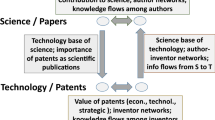Abstract
Citation and referencing data from recent biotechnology patents and bioscience papers is used to show that the bibliometric properties in these two realms are quite similar. Specifically, it is shown that the time distribution of references from both patents and papers are similar, with peak citing at two to four years prior to publication or issue. This is shown to hold for patents citing patents, for papers citing papers, and for patents citing papers. Furthermore, it is shown that there is a very skewed distribution of cited material in both patents and papers, with a relatively small number of highly cited patents and papers, and a relatively large number of documents which are cited only once or twice, or not at all. Finally, it is shown that there is a substantial amount of citation from biotechnology patents to the central scientific literature. We conclude from this that science and technology are far more closely linked today than is normally perceived, and that, in fact, the division between leading edge biotechnology and modern bioscience has alsmot completely disappeared.
Similar content being viewed by others
References
D. J. DE SOLLA PRICE, Is Technology Historically Independent of Science? A Study in Statistical Historiography,Journal of Technology and Culture, 6, 553–568, 1965.
A. J. TOYNBEE, Introduction: The Geneses of Civilizations,A Study of History, 12, vols, 1, 3, New York, 1962.
M. P. CARPENTER, F. NARIN, Validation Study: Patent Citations as Indicators of Science and Foreign Dependence,World Patent Information, 5, No. 3, (1983) 180–185.
M. P. CARPENTER, F. NARIN, P. WOOLF, Citation Rates to Technologically Important Patents,Wold Patent Information, 3, No 4, (1981) 160–163.
M. P. CARPENTER, M. COOPER, F. NARIN, Linkage between Basic Research Literature and Patents,Research Management, 13, No 2, March, (1980) 30–35.
D. J. DE SOLLA PRICE, Citation Measures of Hard Science, Soft Science, Technology, and Nonscience,Communications Among Scientists and Engineers, Chapter 1, 3–22, edited by N. CARNOT, D. POLLACK, Health Lexington Books, Massachusetts, 1970.
F. NARIN, Helen H. GEE, NIH Program Evaluation Reports: An Analysis of Research Publications Supported by NIH and DRR, 1970–1976:NIH and NCI, NIH and NIDR, NIH and NICHD, NIH and NIGMS, NIH and NINCDS, NIH and DRR, U. S. Department of Health and Human Services, Public Health Service, National Institutes of Health, December, 1980.
Institute for Scientific Information,Science Citation Index ®. Philadelphia, PA 19106.
F. NARIN, Rosalie T. SHAPIRO, The Extramural Role of the NIH as a Research Support Agency,Federation Proceedings, 36 No 11 October, (1977) 2470–2475.
M. E. D. KOENIG, Determinants of Expert Judgement of Research Performance,Scientometrics, 4, No 5 (1982) 361–378.
F. NARIN, Evaluative Bibliometrics: The Use of Publication and Citation Analysis in the Evaluation of Scientific Activity, Contract NSF C-627, National Science Foundation, March 31, 1976. Monograph: 456 pp. NTIS Accession #PB 252339/AS.
Author information
Authors and Affiliations
Rights and permissions
About this article
Cite this article
Narin, F., Noma, E. Is technology becoming science?. Scientometrics 7, 369–381 (1985). https://doi.org/10.1007/BF02017155
Received:
Issue Date:
DOI: https://doi.org/10.1007/BF02017155




